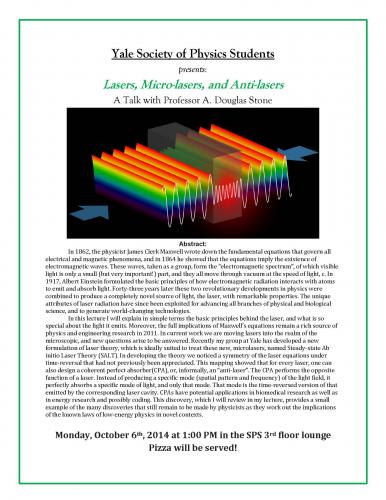
New Haven, CT 06511
Event description:
In 1862, the physicist James Clerk Maxwell wrote down the fundamental equations that govern all electrical and magnetic phenomena, and in 1864 he showed that the equations imply the existence of electromagnetic waves. These waves, taken as a group, form the “electromagnetic spectrum”, of which visible light is only a small (but very important!) part, and they all move through vacuum at the speed of light, c. In 1917, Albert Einstein formulated the basic principles of how electromagnetic radiation interacts with atoms to emit and absorb light. Forty-three years later these two revolutionary developments in physics were combined to produce a completely novel source of light, the laser, with remarkable properties. The unique attributes of laser radiation have since been exploited for advancing all branches of physical and biological science, and to generate world-changing technologies.
In this lecture I will explain in simple terms the basic principles behind the laser, and what is so special about the light it emits. Moreover, the full implications of Maxwell’s equations remain a rich source of physics and engineering research in 2011. In current work we are moving lasers into the realm of the microscopic, and new questions arise to be answered. Recently my group at Yale has developed a new formulation of laser theory, which is ideally suited to treat these new, microlasers, named Steady-state Ab initio Laser Theory (SALT). In developing the theory we noticed a symmetry of the laser equations under time-reversal that had not previously been appreciated. This mapping showed that for every laser, one can also design a coherent perfect absorber (CPA), or, informally, an “anti-laser”. The CPA performs the opposite function of a laser. Instead of producing a specific mode (spatial pattern and frequency) of the light field, it perfectly absorbs a specific mode of light, and only that mode. That mode is the time-reversed version of that emitted by the corresponding laser cavity. CPAs have potential applications in biomedical research as well as in energy research and possibly coding. This discovery, which I will review in my lecture, provides a small example of the many discoveries that still remain to be made by physicists as they work out the implications of the known laws of low-energy physics in novel contexts.